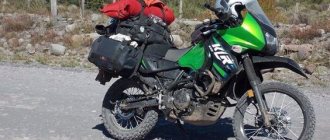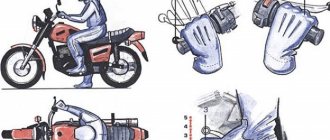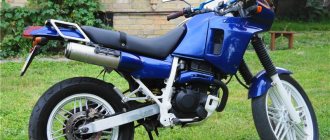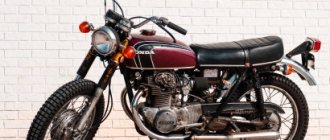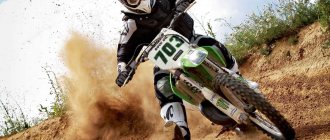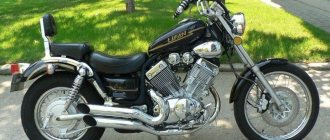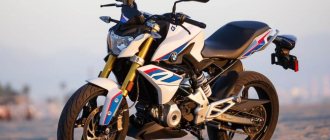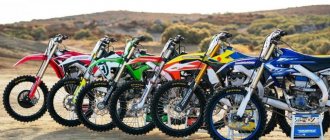One of the most popular motorcycles among beginners is the Honda CB 400 SF. Replacing the Honda CB1 on the assembly line, this bike first went on sale in 1992 , having gone through several restylings since then. It is still produced, still remaining in demand in the markets of many countries. And in Russia, the popularly beloved “Siberian Sea Horse” is the first two-wheeled steel horse for almost a third of all novice motorcyclists.
Design
Honda CB 400 Super Four is a classic incarnate . Japanese engineers decided not to risk flirting with newfangled trends, and for more than a quarter of a century they have been producing approximately the same motorcycle, which has changed only slightly during this time. A round headlight, a flat seat, an elongated gas tank... The Honda CB400 looks like something from the last century, and at the same time looks organic on city streets. This is partly why it is so popular - the classic design appeals to many bikers.
Model history
Over its more than twenty-year history, the Honda CB 400 has undergone minor changes. At the same time, the main units did not change radically. Thus, on the Honda cb400 sf model until 1995, there was no fuel sensor on the dashboard, and in order to find out the amount of gasoline you have to look into the gas tank. Since 1995, the Version R has had a square headlight, a small windshield and a different shaped exhaust pipe.
Read other motorcycle reviews Honda cb 600 motorcycle review
Motorcycle Honda CB400
Since 1996, the Honda cb400 family has been expanded with a sports model. The Honda cb400 ss has a conventional round headlight, the maximum speed is increased to 13 thousand, the carburetor is configured for dynamic driving. Minor changes have been made to the rear pegs, and the tail of the motorcycle has become more streamlined. The model is equipped with more tenacious brakes, the calipers of which, unlike conventional ones, are painted golden.
Technical characteristics of Honda CB 400
One of the reasons for the commercial success of the Honda SB 400 is its balanced technical characteristics. This bike handles well, accelerates briskly, brakes confidently and is highly reliable . He is not without some “childhood sores”, but he has more advantages than disadvantages.
Engine
As time has shown, the Honda CB 400 engine turned out to be the most reliable when compared with other 400 cc motorcycles. It is a liquid-cooled inline 4-cylinder power unit ( 53 horsepower and 38 Nm of torque ). Starting from the second generation, that is, from 1999, it acquired the VTek , which the first version of the Honda SB 400 was deprived of, becoming more economical. The engine did not lose its agility, providing acceleration to 100 km/h in 4.5 seconds . The maximum speed of the motorcycle is 180 km/h , and it is really capable of reaching it.
Transmission
The motorcycle is equipped with a 6-speed gearbox , trouble-free, like a Swiss watch. With proper maintenance, a gearbox can serve for decades without breakdowns or repairs, and there are practically no problems with it.
Chassis and brakes
Duplex steel frame , 43 mm telescopic fork at the front, short-stroke shock absorbers at the rear - the design is classic. The Honda CB 400 suspensions may not be the stars of the sky, but they are durable and versatile. The rear shock absorbers are preload adjustable.
Braking is handled by 2-piston calipers (since 1996 - 4-piston ) with two 296 mm discs at the front and a 1-piston caliper with a 240 mm disc at the rear. Since 2008, all versions of the Honda SB 400 have been equipped with an ABS system . Considering the moderate weight of the motorcycle, all of the above is enough for it to brake very effectively.
Electronics
Electronic equipment in the Honda CB 400 is minimal. Analog dashboard, lighting, battery, generator - that's all. Therefore, the electrical circuit of the motorcycle is simple, and if you have a manual at hand, any novice electrician can figure it out. And thanks to the well-thought-out design, there are practically no problems in the on-board network of the bike.
Weight and dimensions
According to these parameters, the Honda CB 400 Super Four is a strong mid-ranger. The length of the motorcycle ranges from 2045 to 2080 mm depending on the year of manufacture, width - from 720 to 735 mm, from 1070 to 1160 mm. Seat height - from 755 to 775 mm. Dry and curb weight - 168-173 and 189-200 kg, respectively.
Controllability
This is one of the biggest reasons why the CB400 is so popular. The motorcycle handles superbly, it obediently responds to any efforts of the driver and easily maneuvers in traffic. Tenacious brakes and dynamic acceleration allow the Honda SB400 to feel like a fish in water in the city.
Fuel consumption
It differs significantly in the first two generations and in all subsequent generations. The least economical are the old Seabikhs, without VTec and with four carburetors. But since 2003, an injector began to be installed on the CB400, and average fuel consumption dropped to 4.5-5 liters . In the city it can go even more, on the highway - a little less, if you maintain the cruising speed within 110-120 km/h. The bike readily consumes AI-92, but, according to reviews from owners, gasoline consumption on AI-95 is slightly lower.
Maintainability
How much will it cost to repair a Honda CB400?
The motorcycle has proven itself to be a reliable unit without any problems with operation and repair. The only generally recognized defect is the malfunction of the relay regulator. This device often fails and cannot be repaired. Replacing a part will cost approximately 1000 rubles and 5 minutes of time. The power unit is quite reliable under normal operating conditions, but in case of wear, it is better to replace the unit completely. You can order it in specialized stores. A contract engine, depending on the year of manufacture, will cost from 26 to 39 thousand rubles.
Maintenance
In terms of maintenance, all Honda cb400 models are not particularly picky. As consumables, only the air filter can be replaced, which is replaced during maintenance or as needed. When used in harsh conditions, the air filter becomes clogged, resulting in reduced power and increased fuel consumption. In some cases, the motorcycle begins to jerk when changing gears. Fixing this problem will cost about 700 rubles; you can do the work of replacing the filter yourself.
Motorcycle price
The cost of a used Honda CB 400 can range from 100 to 300-350 thousand rubles , or even more. This model is still produced, but officially it is sold only in Japan, and gets into other countries through the efforts of “gray” dealers. Copies of the first generation can now be found on the secondary market for 100-120 thousand rubles , in a condition ranging from “it will reach the garage and die quietly there” to “a lively and vigorous old man.” The general trend is clear - the younger the motorcycle, the more expensive it is.
Repair and tuning
Due to the enormous popularity of the model, there are enough original spare parts, copies from other manufacturers, and tuning. On average, the cost of any parts is comparable to that for most other Japanese bikes, with the exception of particularly expensive models like the Honda Gold Wing and Suzuki Hayabusa.
Repair
Most of the Honda SB400 models riding on Russian roads have already had a dozen or two owners, and it is unlikely that all of them took good care of their two-wheeled steel horse. Therefore, despite the phenomenal survivability, technical problems sometimes occur. But there is no general trend; the Honda CB 400 is extremely reliable, and all possible breakdowns are most often caused by untimely maintenance.
Spare parts
In large cities, they are usually available in motorcycle shops, and you can buy almost anything - this is due to the popularity of the model. And through services like Exist and Megazip you can order everything that is not in stock. The price of spare parts is quite reasonable.
Tuning
Most owners of the Honda SB 400 limit themselves to visual tuning of the bike, because there is little point in improving what is already good. For many of them, this motorcycle is “passable”; they expect to change it to a more powerful one in a year or two, and therefore do not consider it necessary to invest in tuning.
Service
Consumables
| Battery | Yuasa YTX9BS |
| Oil filter | HM 15410-MM9-PO1 (Honda) HIF HF303 (HI-Flo Filters) |
| Air filter | HM MY9K1 (Honda) Champion J301 HFA 1402 (Hi-Flo Filters) |
| Front tire | Bridgestone BT 45 |
| Rear tire | Bridgestone BT 45 |
| Brake fluid | DOT 4 |
| Front brake pads | FA142 - Kevlar (EBC Brakes) FA142HH - Grooved (EBC Brakes) BB-H030 (Brembo) Sport Compound BB-H030RR (Brembo) Racing Compound FD-B570SS (Ferodo) Supersport 2р-202 (Nissin) FD-B533P(Ferodo)- for CB400SF from '96 (CBR900RR). VD-156 (Vesrah) p188 (Premier) SBS 627 MCB 598 (Lucas) |
| Rear brake pads | BB-H027 (Brembo) Sport Compound BB-H027RR (Brembo) Racing Compound FERODO FDB531 599/599LF (Lucas) 2p-204 (Nissin) |
| Front right disc | FA1132RS (EBC Brakes) |
| Front left disc | FA1132LS (EBC Brakes) |
| Front brake cylinder | MSB 102 |
| Rear shock absorbers | F10.29.7610-1512 (KONI) |
| Rear disc | FA1020 (EBC Brakes) |
| Clutch | CK1228 (EBC Brakes) |
| Clutch spring | CSK6 (EBC Brakes) |
| Candles | NGK CR8EH9, CR9EH9 |
| Fork seals | 41x54x11 Honda 51490-mn8-305 oil seal, boot 51415-mm8-003 upper guide 51414-mn5-003 lower guide Vesrah 4102 (set seals + boots) |
| Relay regulator | 31600-MV4-010 |
| Headlight bulb | H4 60/65W |
Refueling volumes
| Engine oil | After draining: 3.0 l After draining and replacing the oil filter: 3.2 l After disassembling: 3.8 l |
| Cooling system | 2.2 l |
| Brake system | 2.0 l |
| Fuel tank | 18 l |
Choosing engine oil
Guides and manuals
For motorcycle without Hyper Vtec, 1992-1998.
Service manual in Japanese, PDF, 4 MB.
For motorcycle with Hyper Vtec, from 1999 onwards.
User manual in Russian translated from Ivan EMIV, PDF, 5 MB.
User manual for Spec 1, Spec 2, Spec 3 in English, PDF, 19 MB.
Service manual for Spec 3 in English, PDF, 110 MB.
Service manual for Spec 1, Spec 2, Spec 3 in Japanese, ZIP, 43 MB.
Motorcycle modifications
The Honda SV 400 SF has lived a long life, having changed considerably during this time. The year 2003 was an important milestone in the history of the development of the model - the third generation, Honda CB400SF Revo, was released with the Vtec 3 system, which replaced the Vtec 2 that had existed for only a year. It was since 2003 that all CB400SFVs received the third generation Vtec.
Honda CB 400 Four 1992
The very first generation of “Sibihi”, without Vtec and with Keihin CV 32 mm carburetors. It became the basis for all further incarnations of the “Sibiha”, and all of them, even those released this year, have a lot in common with it.
Version R 1995
This configuration was produced until 1998 inclusive, differing from the standard one by the presence of a plastic fairing and a square headlight instead of the classic round one.
Version S 1996
In parallel with the Version R, the CB400SF Version S was also produced, with the missing center stand, sporty tuned Keihin carburetors and reinforced 4-piston calipers on the front brake discs.
Version VTec 1999
The first Honda SB400 with the Hyper VTec . Since 1999 , it has been installed on all copies.
Version VTec 2003
A motorcycle with an injection instead of four carburetors. Subsequently, carburetor versions of the CB400 were no longer produced.
Determining the year of manufacture by frame number
| Model | Years of manufacture | Frame number |
| CB400SF 2N | 1992 | NC31: 1000001-1034643 |
| CB400SF 2R | 1993 | NC31: 1200001-1212250 |
| CB400SF 2S | 1994 | NC31: 1300001-1307373 |
| CB400SF 3S | 1995 | NC31: 1350001-1354811 |
| CB400SF 2T | 1996 | NC31: 1400001-1401880 |
| CB400SF 3T | 1996-1997 | NC31: 1450001-1456784 |
| CB400SF 2V | 1997 | NC31: 1500001-… |
| CB400SF 3V | 1997-1998 | NC31: 1550001-… |
| CB400SF Fx | 1999 | NC39: 1000001-1007220 |
| CB400SF | 2000 | NC39: 1010001-1019999 |
| CB400SF F1 | 2001 | NC39: 1020001-1029999 |
| CB400SF F2 | 2002 | NC39: 1030001-1039999 |
| CB400SF F3 | 2003 | NC39: 1040001-1049999 |
| CB400SF F4 | 2004 | NC39: 1050001-1099999 |
| CB4005, CB400S5 | 2005 | NC39: 1100001-… |
| CB4006, CB400S6 | 2006 | NC39: 1200001-… |
| CB4007 | 2007 | NC39: 1300001-… |
| CB4008, CB400S8, CB400A8, CB400SA8 | 2008 | NC42: 100001-… |
| CB4009, CB400S9, CB400A9, CB400SA9 | 2009 | NC42: 110001-119999 |
| CB400A, CB400SA, CB400Aa, CB400SAa | 2010 | NC42: 120001-129999 |
| CB400B, CB400SB, CB400Ab, CB400SAb | 2011 | NC42: 130001-139999 |
| CB400C, CB400SC, CB400Ac, CB400SAc | 2012 | NC42: 140001-149999 |
| CB400D, CB400SD, CB400Ad, CB400SAd | 2013 | NC42: 150001-159999 |
| CB400E, CB400AE, CB400SE, CB400SAE | 2014 | NC42: 160001-169999 |
| CB400AF, CB400SAF | 2015 | NC42: 170001-179999 |
| CB400G, CB400AG, CB400SG, CB400SAG | 2016 | NC42: 180001-189999 |
Advantages and disadvantages
This model has more positive qualities than disadvantages, which was the reason for its unprecedented popularity. If you take proper care of your bike, it will last for decades.
Advantages
- Phenomenal reliability . Problems, of course, do happen, especially with older copies, but still.
- Huge resource . Many Honda CB400 Super Four have already covered several hundred thousand kilometers, and their engines are still in no hurry to retire.
- Controllability . Any beginner can handle a bike, with some skills, of course.
- Cost of service . In terms of maintenance, the motorcycle will not fit into the pocket, and it is unlikely to ruin its owner.
- Economical . If you don’t twist the throttle “all the way”, fuel consumption will be very moderate.
Flaws
- Reputation as a " beginner's bike ". Because of this, many owners do not take proper care of the bike, hoping to sell it soon. Therefore, many copies of the Honda SB400SF are in mediocre technical condition.
- Relatively weak suspensions . It is not recommended to drive off paved roads, especially if there is a passenger.
- Sometimes the charging relay fails.
Description and features of the motorcycle
The Honda SB 400 continues to meet the demands of motorcyclists to this day. Sufficient power combined with moderate fuel consumption make the bike in demand.
Not to mention the appearance, which lovers of the classics will definitely appreciate.
Design
The 1992 Honda received a steel duplex frame and a double rear shock absorber. The fuel tank remains the same classic shape as on the CB-1, but the new model has a single handlebar. According to modern classification, the bike is a naked bike.
Make the bike in demand to meet the requirements of motorcyclists
Weight and dimensions
The length of the motorcycle is 205 cm, width 72.5, and height 107. How much a Honda motorcycle weighs depends on the modification. The CB400 NC39 weighs 168 kg. The dry weight of the NC42 is 170 kg, and the NC31 is 173.
Owner reviews
I bought a motorcycle in May 2022, year of manufacture 1999, first with Vtek, dragged from Japan from auction. In fact, I bought it purely from the photo, before that I had only sat on the same model and tried it on. Mot arrived alive, vigorous, with scratches on his sides, but all this was visible in the photographs. I’m still driving it, there are already 46k km on the odometer, although the mileage is 100% correct. The bike is very peppy, the technical characteristics are up to par, I like everything. Evgeniy, St. Petersburg.
An excellent moped with a comfortable fit, the size and weight are a little annoying, but this is an individual problem (height 161, weight 50+). I rode for two years until it was stolen, then I switched to a Jixer 600. Alina, Moscow.
Sibikha Super Four is the best motorcycle for driving around the city, and not only. I compared it with the XJR 400, the difference is huge, and not in favor of the Yamaha - it’s heavier, more clumsy, the brakes are worse. Honda rules! Sergey, Krasnodar.
Summary
Advantages
- Classic timeless design.
- One of the most inexpensive options in the 400 cm3 class.
- Reliable, repairable, no problems with spare parts.
- Maneuverable and dynamic. Light weight.
Flaws
- There are many motorcycles on the market that are in poor condition because... Very often this motorcycle is taken for study.
- Soft front fork. The problem is solved by installing stiffer springs or replacing the oil with a more viscous one.
- Problematic regulator relay on models before 1999. The relay itself is not expensive, but it is worth carrying a spare one when traveling long distances.
- The exhaust manifold under the bottom beats during unsuccessful exits from curbs. The solution may be to install a power steel plow.
- Sensitivity to air filter contamination.
Conclusion
The Honda CB 400 gives new riders what they need - balance . This bike is a strong mid-ranger in all respects; it accelerates quickly, brakes confidently and maneuvers well . In addition, it is inexpensive, which is also important.
Specifications
| Maximum engine power: | 53 HP |
| Torque: | 38 Nm |
| Working volume: | 399 cm3 |
| Motor type (cylinder arrangement, number of strokes): | 4-cylinder, transverse DOCH, PGM-FI fuel injection system |
| Number of cylinders: | 4 |
| Number of valves: | |
| Intake type (Injector / Carburetor): | |
| Bore and stroke: | |
| Starting system (Electric starter, kick starter): | |
| Maximum speed in km/h: | 180 km/h |
| Cooling system: | Liquid cooling |
| Transmission (gearbox): | 6 |
| Clutch (Dry / Wet): | |
| Drive unit: | Chain |
| Frame: | Steel duplex frame |
| Chassis | |
| Suspension (front/rear travel): | |
| Brakes (Front/Rear): | |
| Wheels / Tires / Rubber: | |
| Dimensions and weight | |
| Dimensions (Length / Width): | |
| Seat height: | |
| Ground clearance: | |
| Curb weight: | |
| Wheelbase: | 1455 mm |
| Weight: | 189-200 kg |
| Fuel tank capacity: | 18 l. |
| Battery capacity: | |
| Year of release: | |
| Country of Origin: |
Good day, BP! I used the search here and realized that on our favorite site there is no normal post about the most common motorcycle in the vastness of the Russian Federation and the CIS countries... Yes, I’m talking about Sibikh. Meet: Honda cb400sf (aka SuperFura, aka Sibikha, aka Fura, Furia, etc.) =) I think that this motorcycle deserves more attention to itself. Therefore, I decided to correct this annoying omission)))) This will be a review, feedback, comparison, features of operation and technical. maintenance, tuning, etc. By tradition, let's start from afar. Having driven the Duke for 1.5 seasons, by chance and desire, if anyone remembers (for those who don’t remember), I became the owner of a 2006 Honda cb400 Super Bol D'or And now, after 14,000 km. mileage, I decided that it was time to describe this motorcycle and all its aspects as fully as possible from my bell tower. If you are interested, you are welcome to come and have tea with us =)
Comparison with Duke
Duke is my first road builder, who left behind a lot of impressions and experience for me. No offense to him, after all, after all my falls, he regularly took me to the traffic police station and to the house himself, but the quality of the Honda is higher. An order of magnitude higher. It is in everything: in the design of components, in materials (there are also some flaws here, but more on that later), in the alignment of lines and ergonomics, and even in service intervals. Oil change: Duke-5000km, Fura-12000 (I change at 10). Externally, the Seabikha is larger, more comfortable, the handlebars are further away, and the saddle height is lower. Afterwards, when you sit on the Duke, you feel like you’re on a stool or a supermoto-like motorcycle. For me with my height of 185 cm and 80 kg. The weight on the Duke is not comfortable and it’s even visually small for me. I chose Boldore because I like it better, and also because I drive on fast roads 80% of the time and need wind protection.
As they say: “You meet someone by their clothes...” Therefore, let's start with appearance.
Design
Sibihi's design is timeless! It is so precise and perfect that even hardened sports enthusiasts will say: “Yes, this is exactly what a motorcycle should look like!” Indeed, looking at a Fura of any year and at any time (and even before) we can say that it looks and is in harmony with the image of a real bike. It looks equally appropriate to see a man in a leather outfit or just a turtle, see for yourself:
In one word it is called
“Classic!”
As far as can be judged by the number and some polls on social media. networks, the classic version is more popular with us, but it is quite possible not only because of the appearance, but because dropping the classic is cheaper than Boldore. Personally, with my speeds, I needed a Boldor with a fairing and I like it better, it’s just 2 in 1. In classic mode, at speeds above 140 it’s no longer very comfortable, you want to hide (the numbers appear on the Internet are 100-120, maybe my helmet just has good aerodynamics). On Boldora I’m quite comfortable up to 160 without bending too much, then it’s easier to lie down behind the windshield. There are also extended windshields, but about them in the tuning section.
If the numbers tell someone something, I’ll give you some data from the performance characteristics (I’m giving them for my motorcycle, Boldor 2006): Length: 2040.0 mm Width: 2040.0 mm Height: 1155.0 mm Ground clearance: 130 mm
When getting on a motorcycle, the first thing we see in front of us is the instrumentation and controls, so now let’s discuss them.
Controls and instrument panel
What do we see here? Again a classic. Analog speedometer and tachometer, minimum electronics and maximum information content. Personally, I don’t like that Trip 1 and Trip 2 only count up to 1000 km and then reset, this is nonsense.
The Sibishka has a wide steering wheel and standard control panels. In my case, the mirrors are from Honda SBR600, but this does not change anything, they just have a slightly different shape of the mustache. Their information content is quite good, I can’t complain. Your hands on the steering wheel are free and comfortable, all the buttons are within reach of your thumbs, except for the emergency lights. Apparently it was not intended that it would be used on the go, and therefore it is difficult to turn it on and off without pulling the gas, a kind of acrobatics for the right hand. Not critical, but a minus. I also want a shorter-throw throttle grip, otherwise it’s impossible to unscrew it normally without intercepting it. Maybe I'll do this in the winter or spring. The standard brake and clutch handles are quite good steel, but according to tradition, I replaced them with short adjustable ones. We smoothly move on to the engine and gearbox, and as a result to acceleration, gear shifting and maximum speed
Engine and gearbox
This is the most legendary part of the motorcycle. They say they are unkillable, although if you are a handyman, then you can kill everything and, by and large, this is true. Motorcycles that are 20-25 years old ride on the roads and how they ride. What is this if not reliability? Considering also the fact that they are usually “bullied” by newcomers. Yes, this motorcycle is recommended to almost all beginners, and is also used in many motorcycle schools (if not all) along with Jobrik. And this is one more, or maybe 2 “+” for the Sibihi. Tested for years, as they say. But we digress, let's return to the engine and gearbox. A standard in-line four and an ideal (you can argue or not argue, but Honda boxes are already a household name and I didn’t come up with it) gearbox. There is nothing more to say about the structure.
The engine pulls, and pulls across the entire tachometer scale like a steam locomotive! The first kilometers after Duke I felt like I was riding on a steam locomotive that was rushing and rushing. It was absolutely breathtaking. What I mean is that the Seabikha pulls out even from low revs without stalling. But the acceleration is good and vigorous when VTEK is turned on (connecting the remaining 2 valves for each cylinder), that is, after 6700 rpm. Acceleration is enough for more than 0-150, then worse, but still 400 cc and huge weight. 198 kg with a full tank is an extremely inhumane weight for a 400 cc classic, IMHO! The maximum speed is 190 km/h, at which the limiter is triggered and then the engine makes it clear that it’s enough to accelerate. It makes no sense to remove it, because it will add at most 15 km/h to the maximum speed and will immediately reduce the resource of the engine, but do we need it? The gearbox works clearly, loudly and adequately. After Dyukov’s sluggish-soft gearbox, everything here is clear and with a brutal click. The whole traffic light hears that you stuck 1. With timely oil changes and normal clutch discs, there are no traces of any misconnections or failure to engage gears.
I quote data from the manul: Recommended speed
- 1st 0-55 km/h
- 2nd 20-80 km/h
- 3rd 25-110 km/h
- 4th 35-140 km/h
- 5th 45-165 km/h
- 6th 50-190 km/h
The sea bream eats depending on how it happens, if you twist it a lot, if you drive calmly it’s a little bit. Consumption from 3.2 to 8 liters per 100 km. On average, with not very slow (to put it mildly) driving, my consumption is about 5.2 liters/100 km.
Controllability
Controllability is a very relative and subjective concept, so I don’t claim any truth, I’ll just speak out on my own.
For me, a sea bream is quite normal in weight, but for a 400 it weighs 198 kg. somehow not very good, almost more than some 600 current ones. But it is compensated by the low saddle height, only 755 mm , and the low center of gravity.
The steering angle ensures a minimum turning radius of 2.6 m. The motorcycle steers well at any speed. But I couldn’t pass the traffic police lane eight, neither the 1st nor the 8th time... Although, in my opinion, it can be passed normally only on Jobrik, and on a pit pit. For an ordinary person who is not involved in skill driving, naturally. In addition, on later versions the rear handle is very helpful when rolling the motorcycle and rolling it into the garage; without it there is nothing to grab onto normally with the second hand. The bike responds adequately to gas and brakes. The brakes on the Fur are more than sufficient and slow down the motorcycle well, and most importantly, adequately. I never allowed the wheels to lock, but at the same time I always stopped where I needed to or slowed down without critical approaches to foreign objects. Maybe this is also the merit of good tires. I drive a Pirelli Diabolo Rosso 2 120/60-17; 160/60-17 The footpegs are located a bit low and when turning they begin to grip the asphalt very quickly, but this is not a track motorcycle; in the city it’s more of a “+” than a “-“.
Ergonomics and luggage/butt transportation
If I drove a Duke with a passenger and it was fine for me, then even more so. Again, everything is learned by comparison, so now I would say that it is generally impossible to drive a Duke normally with a passenger. So once again I don’t pretend to be the truth. The Sibiha quite cheerfully pulls two, but it becomes very difficult to accelerate to at least 180. But 150 goes fine even in a headwind. To achieve 190, both the pilot and the passenger have to lie low. then yes, it goes 190 in a straight line. I also had the opportunity to ride as a passenger on a Sibikh. I liked it, it’s comfortable to sit and you don’t sit too high. The Duke is like a sporty man on a roost in the back. And there is not enough room for the butt, although this is for me with my 185 cm height)))
With luggage everything is better and without any complaints. Having attached the helmet to the back with a net, you don’t rest against it either with your back or with your backpack, which is always with me (I rested on the Duke and it was uncomfortable to sit). The standard 4 mesh engagement points are very pleasing. Very comfortably! The tank is quite flat and low, so a luggage bag can easily be attached to it and not only does not create discomfort, but also adds convenience. Let me clarify: on highways at speeds of 150-190 you want to lie down on the tank, but it’s low and you can’t do this without bending over. And when there is a bag with things on the tank, you can lie down on it and calmly ride while lying down. It really relieves your back and adds comfort. Naturally, I’m not talking about huge bags, but about these options:
There are also a lot of pannier systems for the Sibikha, but in general I don’t like panniers on this kind of motorcycle and therefore I’m not going to install one for myself. Cases for example:
I myself even managed to transport such a huge piece of DorBlue isolon shield to Furochki: XD
I am very pleased with the presence of glove compartments in the sides of the front plastic and under the seat. It fits under my seat and is always there: a tire repair kit, a luggage net, a motorcycle cover and now a DB killer. The sides contain: a cable for fastening the helmet to the motorcycle and headphones. The left glove compartment is locked with a key. In general, I don’t understand why other motorcycles with side plastic don’t have glove compartments in them...
Those. service
The Furochka is not only one of the most reliable motorcycles, but also has a huge selection of original and non-original spare parts. All of them are not very difficult to find and buy, most are even in stock in Moscow time, and you don’t have to wait for the order to arrive. Many services deal with seabirds, which is also good news. Service intervals allow you to not spend much on maintenance. For some, they even have to change the oil only once a season, because not many people drive more than 10 thousand km. in season. Anyone who says: “But the carburetor...”, hinting at the need to synchronize and clean them, will be right in his own way, but on a SuperFura with well-tuned and cleaned carbs you will be at 20,000 km. you will forget about them altogether. Personally, the Sibishka starts up for me without any suction up to +10 degrees of the average daily temperature, I just have to turn the throttle a little at first so that it doesn’t stall and that’s it. And with the suction in any weather, it rumbles like half a kick))) But changing the spark plugs is not so easy; you can only get to one of the 4 spark plugs if you remove one of the high-voltage wires or unscrew and move the neck of the cooling system. In general, it’s still hemorrhoids.
Tuning
The most mandatory tuning is sliders and/or roll bars. Because in a normal fall without them, this is minus the cover on the right or left and then on the tow truck. There are a lot of tuning options for the SuperFuru, ranging from clutch and brake levers to full exhaust systems and lighting equipment. Most of the tuning really has to be ordered, but this is not only the case with the Sibishka. There are huggers, extended windshields, steering wheels, etc. for inhumane prices, as well as quite affordable levers, Chinese direct flows (some of which are no worse than famous ones), lifting kits and other goodies. For example:
My personal comments on the motorcycle
Let's start with the disadvantages and problems that I found for myself:
- Ugly front turn signals. Yes, they are expensive, have poor mounting and a terrible appearance. Replaced with LED ones, photo below. Although they don’t even stand next to what they put in stock on the Sibier 600rr, when I saw it, I couldn’t say anything at all.
- The location of the collector is under the bottom ; during any not very successful exit from the curb, it hits the ground, which creates wrinkles on it, which is not very good. My solution will be a power steel plow, we’ll do it over the winter. Plastic plows for sale greatly reduce the already not great ground clearance and do not really provide any increase in protection, and even considering their price, they are generally crap.
- Weak suspension. Well, it’s weak, for a soft tourist it’s very normal, but after Duke, and in general, it’s weak. By tightening the rear to maximum and turning the front adjustments to maximum, I achieved at least something, but I will pour thicker oil into the fork. I will not change the rear shocks, since it makes no sense for me to do so. And even more so when you travel alone. Then they are enough normally, more or less, this is still not a sport bike.
- Sensitivity to air filter contamination. If you don’t keep track of its pollution, you risk not going far. My bike stopped accelerating normally, it barely pulled and almost didn’t move. At the same time, it worked smoothly at idle. It started quickly and progressed to serious driving problems within 200 km. Therefore, a spare filter is required for a long-distance trip, and install a new one before the trip.
- You can remove the front fender only by removing the wheel , I won’t even comment on that.
- The footrest constantly gets clogged. So you cleaned the motorcycle's footrest. It slides out and retracts well with a spring. 100 km pass and she again barely moves and there are clear signs that there is mud there. I don’t know the method of treatment, except maybe pull the condol there, I’ll check it later)))
No more cons found.
My buns for the Sibiska
First, a photo, then a description.
By the end of the season, I had invested a lot and it was done:
- Reinforced brake circuits (the adequacy and sharpness of the brakes has increased, albeit slightly)
- Chinese forward flow (but this Chinese can sounds like a masterpiece, I just trudge around and disturb people’s sleep, everything is hardcore)
- Clutch discs have been replaced (now it’s unusual, the speed drops too quickly, you need to get used to it)
- A cigarette lighter with 2 USB is connected and embedded in the glove compartment.
- Front LED turn signals from Duke 200 installed
- New tires are on (and as luck would have it, while I was moving it to a warm garage, I caught a self-tapping screw, fortunately it was at a sharp angle and didn’t go right through... freaks. They scattered shit)
- The plans include a power plow and a mesh for the radiator
But this version of tuning perversion was never brought to life and is unlikely to ever be.
Constructive comments and criticism are welcome!
